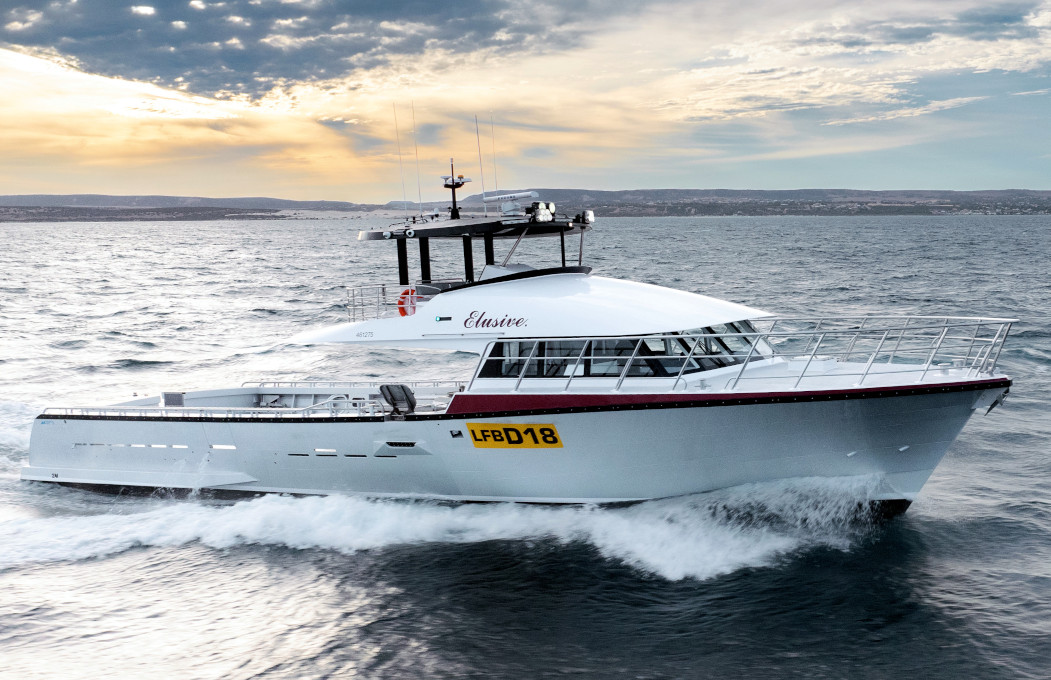Ningaloo Guardian
Diesel outboards for Exmouth Marine Rescue RIB
Dongara Marine tailored an existing design to provide Marine Rescue volunteers in the Western Australian town of Exmouth with a highly capable search and rescue boat that addresses functional and logistics considerations.
Established in 1967 to support the nearby Naval Communication Station Harold E. Holt (a joint Australian and United States navy facility), Exmouth is 1,270 kilometres north of Perth, on the tip of the North West Cape. The district is bordered by the Exmouth Gulf and the Ningaloo Coast World Heritage area. While founded around defence, tourism is now the largest industry: in winter the number of visitors triples the resident population, many drawn by water-based activities including diving and fishing.
To help keep local and visiting boating and other marine users safe, Marine Rescue Exmouth operates along some 160 kilometres of diverse coastline including remote mangrove creeks to Gulf Islands and fringing coral reef along the Indian Ocean.
This requires significant seagoing capability and range / endurance, which is provided by the Dongara Marine-built Ningaloo Guardian.
Featuring a full walk around cabin, the 12 metre rigid inflatable boat (RIB) is a variant of Dampier Legend delivered to Marine Rescue Dampier in April 2024.
Built under contract to the Western Australian Department of Fire and Emergency Services (DFES), Ningaloo Guardian includes a number of customisations in design and equipment to meet Marine Rescue Exmouth’s needs.
These changes included:
- Swapping Dampier Legend’s twin 450hp Yamaha petrol outboards for three 300hp Cox Marine diesel outboards
- One of the four Shockwave suspension seats replaced with a bench seat at navigator’s station
- Additional battery bank for third engine
- Addition of a fresh water system including a 100 litre tank and an external sink
- Plumbed sea water flush toilet in place of Dampier Legend’s chemical toilet
The selection of diesel fuelled engines was driven by refuelling considerations as there is no on-water supply of petrol in Exmouth. The engine change resulted in a significant increase in vessel cost and displacement, affecting speed performance. Although fitted with an additional 50 horsepower, Ningaloo Guardian’s maximum fully loaded speed on trials was 40 knots, some 2.5 knots less than Dampier Legend.
Ningaloo Guardian features the same fully enclosed, walk-around wheelhouse arrangement which provides advantages in accessibility, safety, and docking and mooring. This includes easy movement from the bow to the stern without having to climb up or navigate narrow side decks.
Inside the wheelhouse, there is a full width console forward with helm to starboard and navigation / radio operator position to port either side of the door leading to the forward cabin. Further aft are two crew positions, with one having its own console with navigation system screen.
The electronics package includes three 16-inch Simrad displays, radar, satellite compass, AIS, FLIR gyro-stabilised thermal camera, RDF, and satellite phone.
Accessed through the main console, the forward half / cuddy cabin is primarily configured for storage space but also contains a toilet and refrigerator.
Aft of the wheelhouse is an open work deck with integral towing post, two bench seats above tow reels at the transom, plus an additional seat with stowage below on one side of the wheelhouse door. Up to 12 people can be carried under AMSA NSCV 2C Survey.
Rescue zones, with lower gunwale heights and lift out handrails, are incorporated on each side. A removeable, folding davit can be quickly fitted into the gunwale either side to assist with recoveries from the water.
Marine Rescue Exmouth’s custom RIB also includes:
- Fully air conditioned and thermally insulated wheelhouse for personnel comfort
- Antennas fitted to powered mounts to enable them to be raised and lowered from the helm console, for example when required for medivac operations with helicopters
- Powered hinged mast base enabling controlled lowering and raising, again with remote operation from the wheelhouse
- Lone Star Marine electric drum anchor winch and below chine anchor stowage
- Custom ladder system enabling personnel to embark and disembark vessel over the bow or sides
The Exmouth volunteers are one of 37 Marine Rescue WA groups situated along Western Australia’s coastline from Esperance in the south to Kununurra in the north that are managed and funded through DFES. Another two, in Christmas Island and Cocos (Keeling) Islands, are funded and managed by the Commonwealth.
For more information on Volunteer Marine Rescue Western Australia (VMRWA) visit www.vmrwa.org.au or its Facebook page.
Footnote: Similar vessels have been delivered to Marine Rescue Shark Bay and Marine Rescue Dampier with other 12 metre RIBS currently under construction for Marine Rescue Whitfords, Marine Rescue Mandurah, and Marine Rescue Bunbury.
“This 12 metre rigid hulled vessel is equipped with state-of-the-art electronics and search and rescue equipment. The new vessel will significantly enhance the Group’s capability and further improve safety and response times to marine incidents.”
Hon Peter Forster MLC - Member for Mining and Pastoral Region


